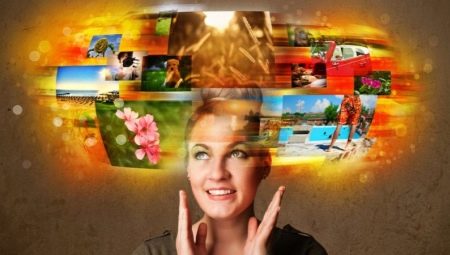Associative Thinking: Description, Application and Development Exercises

People have the ability to actualize the involuntary appearance of another image during the thought process when perceiving a concept. Mental association is an essential feature of the human mind.
What it is?
Associative thinking is based on the connection between concepts, expressed in words. In this case, consciousness easily processes the incoming information without the use of logical analysis. The perception of the world, the generation of ideas and decision making are inextricably linked with the associativity of thinking. Whether a person is well or poorly developed depends on the attention, perception, memory and life experience of a person.
During the acquaintance with a new phenomenon, object, person, the individual's brain begins to work hard. Immediately, a mental comparison with already familiar concepts occurs, specific associations arise. At the next meeting, recognition occurs with the help of previously built associative links.
The more associations that come to mind, the easier it is to remember and reflect. The ability to think figuratively improves the quality of this process.

How does associative thinking work? Imagine this situation: seeing the northern lights for the first time, a person mentally compares it with fireworks, salutes or multi-colored lightning. The slight crackling that accompanies this stunning sight is associated with the crackling of wood in the village stove. And the timbre of the voice of a new acquaintance resembles a pleasant baritone of a colleague, the oval of the face is a neighbor, the gait is of a childhood friend, the name and patronymic coincide with the data of the famous writer.
Associative thinking gives a person a number of advantages. With his help:
- the work of the brain is stimulated;
- memory is strengthened;
- imagination improves;
- an extraordinary fantasy is formed;
- the productivity of cognitive processes increases;
- the perception of new information is facilitated;
- adaptation to extraordinary situations and any life changes intensifies;
- voluntary attention develops;
- the search for solutions to non-standard problems is facilitated;
- new semantic connections are formed;
- unusual ideas are created;
- creativity is manifested in its entirety.

Types of associations
To create associative connections, the abilities of various senses are attracted: smell, touch, taste, sight, touch. The activity of some concepts implements other ideas about objects and phenomena associated with them. For example, hearing the words "sweet", "delicious", "flaky", a person can instantly imagine an object with characteristic features: a pie or cake. The inner language tells him these associations.
Taking into account a number of signs, the following types of associative links between objects are distinguished:
- contrasting, opposite concepts: ice - flame;
- related, similar words: veterinarian - doctor;
- generic names: orange - citrus;
- dominating other words: unit - screw;
- close in space and time, related concepts: fat - pig;
- representing parts of one whole object: nose - face;
- causal relationships: shower - umbrella;
- complementary to one of the concepts: porridge - oil.
Depending on the method and conditions for using words, the following types of associations are isolated:
- words consisting of one root: darkness - gloomy;
- names that have a phonetic relationship: hummock - kidney;
- thematic associations: cook - restaurant.

Scope of application
Associative thinking necessary for easy assimilation of any new information... It helps to realize the most incredible ideas, to successfully advance in professional and educational activities. This type of mental activity is extremely important for musical studies that affect the emotional sphere of a person. Associations contribute to excellent comprehension and memorization of musical works with less effort and time.
Thinking associativity is necessary for people of creative professions: artists, musicians, actors, writers. In order to attract potential customers, marketers and advertising managers use interesting, original, highly detailed associations when creating and promoting advertising products. In this case, the information is easy to remember. Numerous examples demonstrate the importance of using targeted stimulus words in advertising.
For example, the words “tender”, “airy”, “mysterious”, “mysterious”, “chocolate” are floating on the big screen with a demonstration of the packaging design. The buyer turns on associative thinking and is ready to purchase the product.


Signs of violation
Scientists have identified some patterns of mental disorders. Violations in form are associated with a deviation of the associative process of thinking. Violations in content include pathological judgments in the form of obsessions, delirium.
There are several types of disorders of this type of thinking.
- Changing the pace of the thought process can be associated with strong acceleration, noticeably outstripping data processing speed, leapfrogging idea generation and fast decision making. Excessive acceleration is common in manic states. In other cases, thinking can be very delayed, and the event is pondered for a long time, the decision is made with difficulty. Sometimes extraneous thoughts involuntarily invade and interfere with the normal thought process, knock off the desired topic.An unexpected stop of thinking may also occur, during which an involuntary breakdown of current thoughts occurs.
- The mobility and liveliness of the thinking process can be complicated by an abundance of unnecessary secondary details, clarification of the smallest details that are not essential for the disclosure of the topic. The use of unnecessary, distracting associations interferes with the normal thought act. The viscosity of thought leads to the loss of the essence of the conversation, the loss of its productivity.
- Grammatical construction of the text with the use of stereotypical speech turns, stamps, templates, ready-made clichés deprives a person of the opportunity to think independently and expressively. The thought process impairs the incoherent repetition of words, phrases, meaningless phrases and unnecessary sounds.
- Sometimes failure occurs in the focus of goals. A person embarks on empty verbiage, begins aimless ranting. He can deviate from the topic, argue at length on an abstract association, then again return to the original postulate.
Some people express a simple idea too floridly. Sometimes the logic of thinking is violated or contradictory concepts are used.

Development exercises
Thinking is a brain function that needs development and training. Exercise regularly improves the ability to think associatively. Children learn about the environment with the help of associative thinking, which they need for further learning and perception of the world. It is necessary to develop it from infancy. A good associative thought process gives an impetus to the appearance of original images, unusual ideas in children.
Toddlers easily generate new semantic connections. You can develop children's associative-figurative thinking in stages. First, the baby is introduced to objects and related activities. At the next stage, they teach him to generalize the concepts: dress, trousers, jacket, skirt - clothes; boots, sneakers, boots, slippers - footwear.
There are effective exercises. For example, a child is first asked about animals: what they do, what they eat, how they sleep and wash themselves. Then the baby is offered to transform into a particular animal. Let the little man crawl on all fours, try to squeak, sniff and make sounds typical for this animal. The grown-up child must learn to make associative connections, find consistency in the verbal series, analyze objects by signs.
A negative reaction to associations can lead a baby to the development of various complexes. For example, negative emotions are evoked by the associative series: injection - doctor - thermometer - vaccination. In such a situation, you need to tune him in to the positive.
It is necessary to patiently explain to the child that you should not be afraid of the injection, because it helps the person get rid of the disease. It is necessary to listen carefully to the baby's associations, support him, calm him down and instill in him a sense of security.

In adults, associative rows stimulate vigorous thinking. Special training exercises help them better remember new information.
- You need to come up with 2 words that are not logically related to each other, and fit associations between them, this creates an associative chain. For example, "strawberries are money." There may be such a series: strawberry - jam - shop - seller - money.
- A long associative array is obtained by matching to any word of the association. For each subsequent word form, one more associative word is selected. And so it continues until the fantasy runs out. All subsequent words must be somehow related to the initial unit of speech.
- You need to find two words, then find associations that are common to them. For example, the words “berry”, “trees”, “grass”, “shrub”, “hazel”, “glade” are added to the concepts of “green” and “forest”. The two originally conceived definitions apply equally to any of these words.
- The search for unusual associations is great for training mental activity. For example, everyone knows that printed materials are stored in a bookcase. Expected associations: encyclopedia, collections of poetry, magazines, science fiction. But you can think of an unusual row: plates, souvenirs, jewelry, toys, stationery, radio.
- They recommend mentally transforming the scribbles depicted on the sheet into specific images. Pictures of droodle are popular. They initially contain several options for perception, so there is a possibility of using many interpretations. Solving such pictures perfectly develops associative thinking.
- Group exercises involve coming up with concepts in turn when building an associative chain. Words can be selected thematically. The next task may involve indirect associations. After the chain has been drawn up, analysis and exchange of views should be carried out. All participants should explain why they pronounced this particular word.
Such exercises help to sort out your own emotions, feelings and fears.

rules
When doing the exercises, you need to adhere to the main rules:
- associations should not be repeated, each word is used once throughout the game;
- it is necessary to search for original associations, therefore, stereotyped words and superficial concepts must be avoided;
- during a hitch that has happened, you need to slowly say out loud the previous word, present an image and try to evoke associations through it;
- the search for associations should be accompanied by certain sensations in the body, since the bodily reaction contributes to the birth of the most interesting association.
Execution frequency
You need to exercise daily. A good result is obtained when performing various exercises from 1.5 to 2 hours a day. They begin to train gradually. At first, the compilation of associative series can be 20 minutes a day. Then the time increases.
Tips & Tricks
Best of all, bright and unusual events are fixed in a person's memory. They should affect various senses. The associations should be of genuine interest. They need to be well understood, endowed with certain details: color, size, shape. Reading a variety of literature has a beneficial effect on the associative thought process.
It is believed that in women, the associative thought process is faster than logical thinking. The spatial indicator is more developed in men. Experts recommend them to use creative notebooks. There are ready-made prints for creative people with tasks that develop associative thinking.









